Editor’s Note: CNN columnist John D. Sutter is reporting on a tiny number – 2 degrees – that may have a huge effect on the future. He’d like your help. Subscribe to the “2 degrees” newsletter or follow him on Facebook, Twitter and Instagram. He’s jdsutter on Snapchat.
This is the story of a giant pile of beef.
Well, 1.27 pounds (0.58 kilos) of brisket, to be exact.
But before I get into the business of explaining where this meat came from, and why eating this stuff has a massive, unexpected effect on climate change, I feel the need to confess something: That huge slab of brisket, which came to me by way of Snow’s BBQ, a delightful shack of a place out here in the heart of Texas beef country, easily was one of the most food-orgasm-y things I’ve tasted.
The phrase “OHMYGOD” dropped out of my mouth, involuntarily.
And I don’t eat much meat.
A colleague of mine had a better line.
“I mean, f— Al Gore, right?”
I write about climate change for a living and appreciate what the former U.S. vice president has done (or has tried to do, in his own wooden way) to raise awareness about what I consider to be one of the most critical issues facing the planet and people. But, in that moment, I had to laugh and agree with my co-worker.
Forget the climate.
This stuff was too good.
Here, take a look.
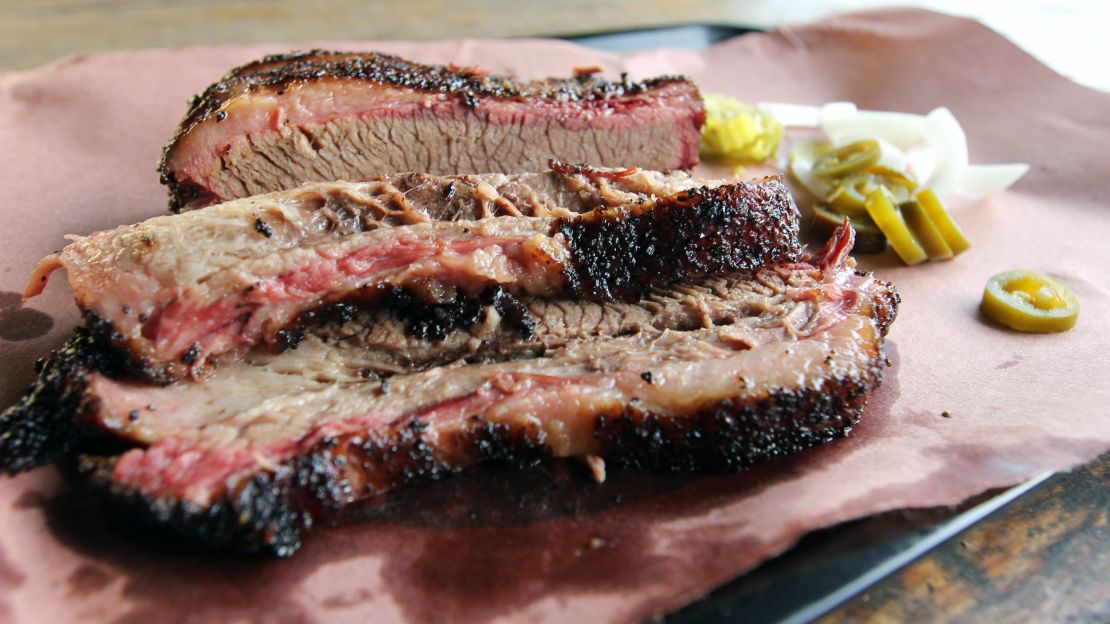
Daniel Vaughn, BBQ editor at Texas Monthly, and the No.1 carnivore I know – this is a man who has developed white bumps on his tongue, apparently from failing to eat nonmeat food groups – helped me dissect the meal. Note the salt-and-pepper “bark” at the edge of the meat, the red tree rings where the smoke that cooks the beef, slowly, overnight, has left its artistic mark. The cloudlike strips of beef were so tender locals insist you peel them apart with your fingers, not a fork and knife.
Knowing the beef’s backstory only adds to the experience.
The barbecue “pitmaster” at Snow’s is 80-year-old Norma Frances Tomanetz. White hair, red apron. Everyone calls her “Tootsie.” Tootsie’s shift starts at 9 p.m. and ends the next day after about 600 pounds of beef have been served. Her recipe is simple: salt and pepper. And, in addition to working here – again, at age 80 – she also serves as a middle-school custodian, helps manage a cattle ranch and takes care of two sick family members. (They could use your prayers, by the way.)
Texas beef people are lovably tough.
You want to root for them.
But there’s “an inconvenient truth” about beef consumption, too, as I would discover on a trip through the supply chain of that meal: Beef is awful for the climate.
Don’t blame me alone for bearing the bad news. In a Facebook poll, thousands of you overwhelmingly voted for me to report on meat’s contribution to climate change as part of CNN’s Two° series. You commissioned this highly personal topic over more widely feared climate change bad guys such as coal, deforestation and car pollution.
Cattle and climate?
They’re not often used in the same sentence.
But eating beef, as I’ll explain, has come to be seen, rightly, in certain enviro circles, as the new SUV – a hopelessly selfish, American indulgence; a middle finger to the planet. It’s not the main driver of global warming – that’s burning fossil fuels for electricity, heat and transportation – but it does contribute significantly.
Globally, 14.5% of all greenhouse gas pollution can be attributed to livestock, according to the U.N. Food and Agriculture Organization, the most reputable authority on this topic. And a huge hunk of the livestock industry’s role – 65% – comes from raising beef and dairy cattle.
Take a look at how beef compares with other foods.
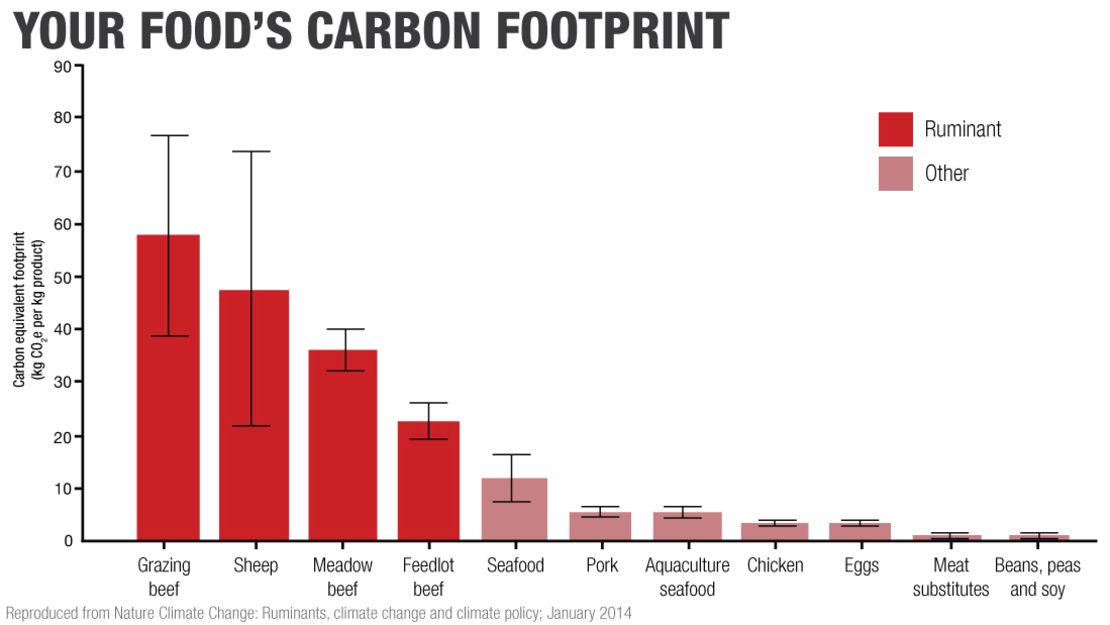
The world is faced with the herculean task of trying to limit warming to 2 degrees Celsius, measured as an increase of global temperature since the start of the Industrial Revolution, when humans began burning fossil fuels. That’s the point at which climate change is expected to get especially dangerous, leading to megadroughts, mass extinctions and a sea-level rise that could wipe low-lying countries off the map. That one little number – 2 degrees – is the subject of international negotiations in December in Paris, which are critical if we’re to avert catastrophe.
We’ve already warmed the atmosphere 0.8 degrees Celsius since the Industrial Revolution; and the World Bank says we’re locked in to at least 1.5 degrees Celsius of warming based on the pollution we’ve already put into the atmosphere.
It will be hard to meet the 2-degree goal no matter what; it will be impossible if livestock pollution isn’t part of the mix, said Doug Boucher, a PhD ecologist and evolutionary biologist who is director of climate research and analysis at the Union of Concerned Scientists.
“We can’t hit that goal without it,” he told me.
In Texas, as in most places, however, no one seems too worried.
“Everybody here in Central Texas goes for beef,” Tomanetz told me. “People are gonna eat what they wanna eat – what their appetites call for.”
Any vegetarians around?
None she’s knows, personally.
“They won’t eat their beef,” she said with a grin, “so somebody else will.”
70-mile meal
It wasn’t long before I wished somebody else had.
The night after I ate at Snow’s, it felt like a grapefruit was trying to climb out of my esophagus. I ate 0.61 pounds of the beef I was served, leaving 0.66 pounds of the stuff on my tray. I gave the leftovers to a guy at the hotel desk because I couldn’t stand to look at it anymore. I felt so crazy-uncomfortable, so full.
The next morning, over a decidedly small, vegetarian breakfast, I calculated the climate change pollution associated with my massive meal. I did so with the help of data from the U.S. Environmental Protection Agency and from Anne Mottet, livestock policy officer at the FAO.
Result: Nearly 29 kilograms of CO2-equivalent gases.
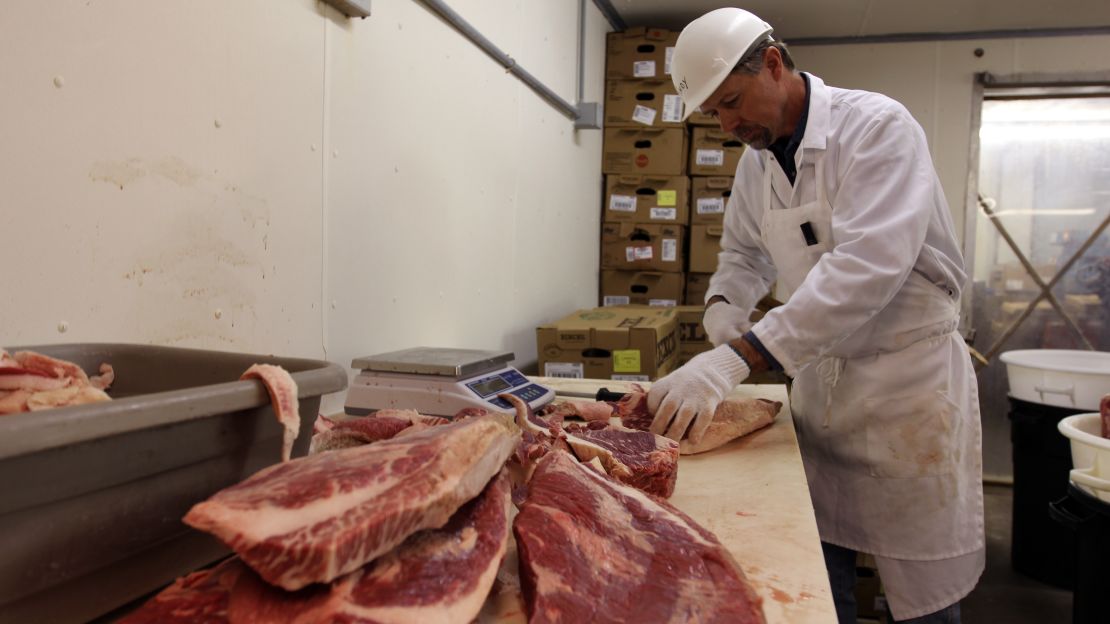
From the atmosphere’s perspective, that’s about the same as burning enough fuel to drive an average American car 70 miles, or 113 kilometers.
A 70-mile meal.*
That’s San Antonio to Austin, Texas.
Granted, this is a beyond-ridiculously-oversized portion of meat. And, depending on how you calculate beef’s climate footprint (Mottet, from the FAO, provided me with her organization’s estimate for beef cattle raised in feedlots in North America), you could arrive at very different results.
Regardless of the exact mileage, however, this is illustrative of an indisputable fact: Beef contributes to climate change in a substantial and outsize way.
Why is that the case?
And where does all of that pollution come from?
I went on the road to find out.
Where are you city slickers?
First stop: I wanted to meet a cow like the one I ate at Snow’s. And, as it turned out, I wouldn’t need to travel far. Kerry Bexley, who opened Snow’s BBQ with Tomanetz in 2003, owns a ranch nearby. Some of the cattle he raises may end up being smoked and served as brisket at the restaurant. Possibly even mine.
If only I could find Bexley and his ranch. I kept getting lost en route.
Where are you city slickers? he asked over the phone.
We’re close!
I had no idea where we were.
We drove maybe 20 miles (an estimated 0.36 pounds of North American beef, in terms of the climate pollution) out of the way before arriving at the rolling green pasture where Bexley raises about 65 or so “momma and baby” cows for slaughter. These cattle chomped on tufts of grass, making hilariously bug-eyed faces while we talked.
Bexley is a gray-goateed guy with an endearing “King-of-the-Hill” twang in his voice. He doesn’t think too much about climate change, but when he does he pictures factories and coal mines – or highways packed with gas-belching cars.
“I would picture the industries – the large industries,” he told me. “A coal-fired power plant or a chemical plant. I think of larger areas, industrial areas.”
Standing in the field, I found it hard to imagine, too.
There’s a bizarrely satisfying explanation for that, though.
You don’t see or hear the cattle burping.
‘Cattle are very polite’
If you want to talk about beef’s contribution to climate change, you really have to talk about cow burps (and, to a lesser extent, farts).
Scientists don’t love the b-word, though.
“We call it eructation,” said Andy Cole, retired research leader at the Conservation and Production Research Laboratory in Bushland, Texas, nearly eight hours by car from Bexley’s ranch. (To avoid that, I flew from Austin. I know, not exactly green of me.)
“Cattle are very polite,” Cole told me. “They don’t burp out loud.”
My bad. Sorry, cows.
Regardless of verbiage, the focus for Cole and other scientists in Bushland is clear: They want to know how much climate-change pollution cows produce as part of their digestive process. I like to think of it as a Cow Burp Research Station.
Their work sounds silly, but it’s vital for two reasons.
One: Cattle digest food differently than we do. They’re ruminant animals, meaning they have multichamber stomachs where a whole bunch of bacteria hang out waiting to digest cellulose from the grass they eat. Humans – like all other nonruminants – can’t digest grass. Cows, goats and sheep can, which is fairly incredible when you think about it. They’re taking plant material that is hard to digest, and not particularly nutritious, and making food out of it. One byproduct of this magical digestive process, however, is methane. An average cow in North America, raised in a feedlot, belches out 117 pounds (53 kilograms) of this stuff per year, according to 2006 guidelines from the Intergovernmental Panel on Climate Change. Pigs and chickens don’t do that.
And two: Methane is a superpotent greenhouse gas, with 25 times as much global warming potential as carbon dioxide, which is the main climate villain.
Understanding how and what we know about the climate-change emissions from beef is so important, because there’s rampant misinformation on this topic. On one hand, you have activists who say, incorrectly, that eating meat, especially beef, is the main driver of climate change. It isn’t. Fossil fuels are. (If you want to get into the weeds on that subject, take a look at this report in the journal Animal Feed Science and Technology. Oh, you don’t subscribe?) Then, you have other environmentalists who claim beef shouldn’t be a big part of the climate conversation – since it will be impossible for the world to meet its climate targets if we don’t get off fossil fuels pronto.
Without jumping into the fray, researchers out here in the Texas Panhandle are collecting data that helps clear things up. They use all sorts of curious, sci-fi methods to try to understand exactly how much methane is produced. They put cattle inside metal chambers, for example, to measure their burps; they have specialized feeding systems that track how much methane comes out of their nostrils while they’re eating a treat; and Richard Todd, a research soil scientist with the USDA’s Agricultural Research Service, is experimenting with lasers as a way to track methane emissions coming off the pastures where cattle are raised.
Todd has arranged these lasers – “not the kind that will burn through steel or anything” – in a crosshatch pattern over a field in the Texas Panhandle.
The near-infrared lasers are set to a frequency that detects methane.
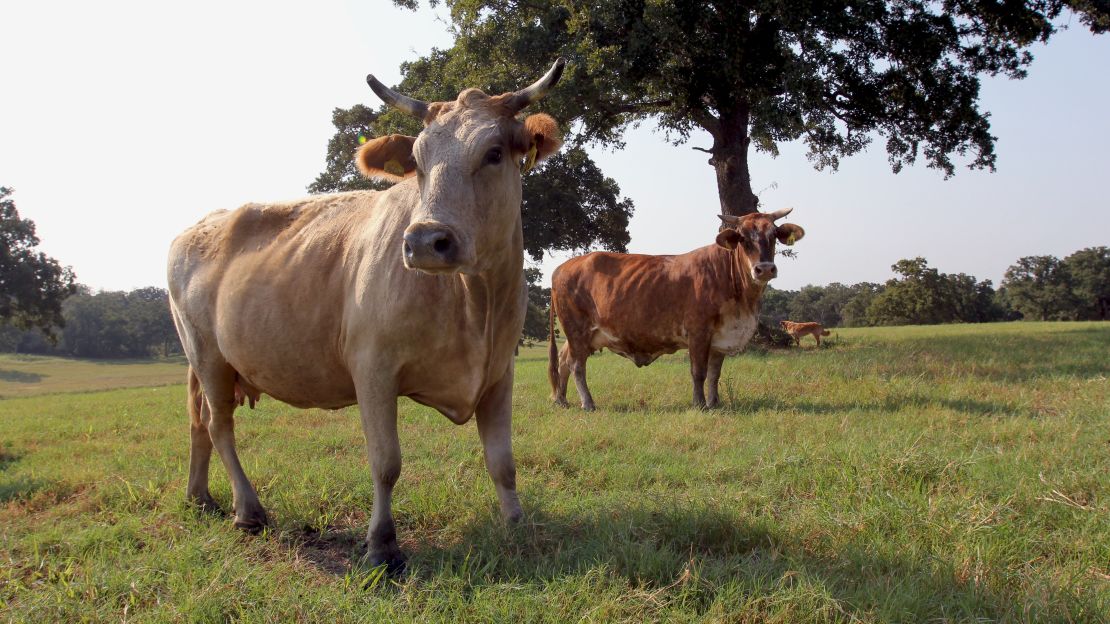
Others, I’m told, are doing similar work from airplanes and cell phone towers.
This invisible pollution adds up. According to the FAO, which bases some of its stats on work like this, 43% of global greenhouse gas emissions associated with beef cattle come from this “enteric fermentation” – or methane burping.
Thinking back to my meal at Snow’s, about 12.5 of the 29 kilograms of CO2-equivalent gases came from burping cows. Of the estimated 70 miles you could drive on that much climate-change pollution, about 30 of them come from cow burps.
It’s the biggest part of beef’s climate footprint.
‘Beef Capital of the World’
Snow’s BBQ buys all of its meat from a wholesaler called O’Brien Meats in Taylor, Texas. Outside, there’s a life-size statue of a cow stuck to the front, like a mermaid on a pirate ship. Inside, I met lab-coat wearing butchers who trim slabs of brisket for Bexley’s exacting specifications. You might think that transporting and refrigerating beef would be a big part of its contribution to climate change. But for all the talk of “food miles,” processing, refrigeration and transit-related emissions from beef production only account for 8% of its footprint, according to the FAO.
To use the miles analogy again, that’s only 5.6 of 70 miles.
Andy O’Brien, who runs the place, told me most of the meat he sells to Bexley likely comes from a feedlot in the Texas Panhandle, possibly in Hereford, Texas, the self-described “Beef Capital of the World,” about 475 miles northwest of the meat shop in Taylor.
So that’s where I went next.
Warren White, the cowboy-hat-and-jeans-wearing manager of Mc6 Cattle Feeders, a feedlot in Hereford, agreed to give me a tour.
The first thing you notice about being anywhere near Hereford is the smell: the sweet-earthy stench of cow manure, strong enough to stick to your shoes.
The smell, though, offers only a hint of how many cattle really are hanging out in this board-flat part of the country. At the Mc6 feedlot alone, the capacity is 55,000 head of cattle. Jayce Winters, spokeswoman for the Texas Cattle Feeders Association, told me 3 million cattle live within a 150-mile (241-kilometer) radius of nearby Amarillo at any given time.
More ruminant animals means more methane burps, of course. And more poop. About 5% of the emissions associated with beef, the FAO says, come from “manure storage and management.”
Walking around a feedlot can ping the this-seems-wrong center of your brain. The cattle are organized in numbered pens that seem to stretch to the horizon. Each animal has a number clipped to its ear, making the cattle look like some sort of now-defunct motorcycle gang. They poop and pee all over the place, sometimes while looking you right in the eye.
Feedlots, which are where more than nine in 10 cattle in the United States spend part of their lives, are bemoaned by many environmentalists and animal rights activists for being allegedly cruel and for their contributions to water and air pollution.
But, when it comes to the climate, feedlot ethics are anything but simple.
That’s because, according to some studies, feedlots actually are the most efficient way to raise beef cattle. This is logical when you think about it, and all comes back to what they’re eating and how long it takes the cattle to grow to “slaughter weight.”
In a feedlot, cattle eat corn, not grass.
So they don’t produce as much methane.
Plus, they’re fattened up quickly, then killed.
So, cynically, that means there’s less time for them to pollute.
That’s partly why the U.S. National Cattlemen’s Beef Association claims this country produces the “world’s most sustainable beef.”
But to fully understand feedlots, you also need to understand the feed.
‘Just like Corn Flakes’
White, the manager of Mc6 Cattle Feeders, walked me to the one part of his feedlot that smells, surprisingly, less like cow s— and more like cereal.
Tons of corn roared out of a grain elevator, landing in a massive heap.
White picked up some of the stuff and sifted it around in his hand.
It was still warm from on-site processing.
“If you add sugar and milk, it’d be just like Corn Flakes,” he said.
At capacity, the cattle here consume 1.5 million pounds of the stuff per day.
Where does it come from?
Somewhere in the Midwest, he told me.
The “somewhere” I visited on the final stop on this beef-climate odyssey was Auburn, Illinois. That’s where I found Garry Niemeyer, a corn and soybean farmer, and former president of the National Corn Growers Association, who told me he sells most of his corn to feedlots such as White’s in Hereford, Texas. (Some of it, he said, is used to produce ethanol and then byproduct of that becomes food for cattle.)
I met him on the first day of harvest: September 8.
Niemeyer and I rode in an air-conditioned tractor while enormous red “combine” machines started the several-day process of mowing through his rows of corn. These machines are incredible up close: They not only snap the corn stalks, they remove the ears of corn – each stalk has only one – and almost-instantly strip the school-bus-yellow kernels of corn off the dimpled cobs, and toss the cobs aside.
It’s not the harvest that creates the most climate pollution here, however.
It’s the fertilizer.
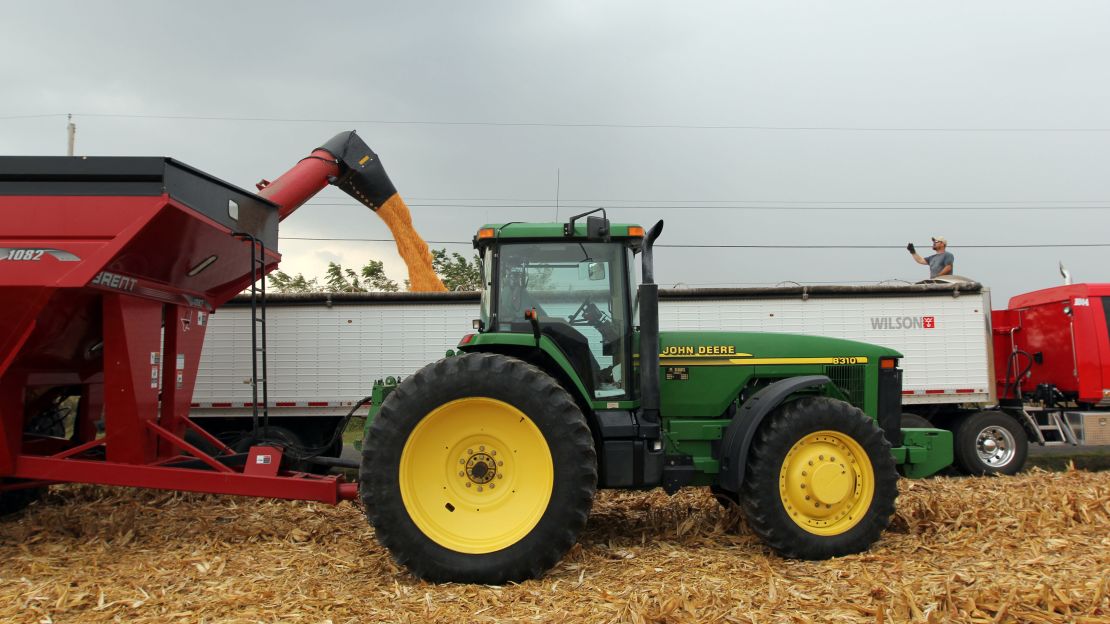
Niemeyer told me he “applies” 0.79 pounds of nitrogen fertilizer per bushel of corn. Some of that is “knifed” into the ground with giant farm equipment, and other times it’s sprinkled on the surface of the land. Some of it is liquid, some of it is solid pellets. Fertilizer is expensive stuff, and Niemeyer uses less than he used to – down from 1.2 pounds per bushel in the 1990s, he told me, proudly noting that this reduces pollution in a nearby lake and the Gulf of Mexico, which suffers an oxygen-dead zone in the summer because of excessive fertilizer runoff.
But it’s still a huge amount. And one unwanted offshoot of all this fertilizer use – and something people out here aren’t thinking much about – is nitrous oxide.
Nitrous oxide is kind of the ultimate greenhouse gas.
About 300 times as powerful as CO2.
Largely because of fertilizer, producing food such as corn for beef cattle accounts for 36% of greenhouse gas emissions from beef and dairy, according to the FAO.
When it comes to beef, it’s second only to burps.
And growing food for our food takes a wider environmental toll.
About 70% of this planet’s agricultural land is used for livestock production, according to a 2006 report from the FAO. And in total, 30% of all terrestrial land on Earth – all of it! – is used for livestock.
These are truly astounding figures.
True, some of that land is well suited for cattle grazing. “Eighty-five percent of the land we produce cattle on in the United States isn’t suitable for other food production,” said Daren Williams, spokesman for the U.S. National Cattlemen’s Beef Association. “You can’t turn the Flint Hills of Kansas into spinach fields.”
“The argument that we should stop raising ruminant animals on land that is made for ruminant animals is frankly nonsense,” he added. “We’d be taking vast amounts of land out of food production at a time when we need more not less” because of population growth.
These land-use choices do matter, though.
Internationally, for example, rainforests very often are cleared to make room for beef cattle. In the Amazon, cattle production accounts for an estimated 50% to 80% of all deforestation, according to Boucher from the Union of Concerned Scientists.
Deforestation is one of the reasons beef from Latin America and the Caribbean is among the worst, per pound, in terms of its effect on climate change. (Europe, North America, Russia and Australia are among the more-efficient beef producers, according to the FAO.)
“Cutting down forests means you’re cutting down trees, and half of the tree is carbon,” said Boucher. “When you burn it or let it rot, that produces carbon dioxide.”
Carbon dioxide, of course, is a heat-trapping gas.
These so-called “land use changes” make up 15% of beef’s overall contribution to climate change.
‘Meth corn’
In Illinois, I watched cornfields zip by the window as Sean Bolton (spelled “like Michael Bolton,” he told me) drove a truck full of Niemeyer’s just-harvested corn down the highway to a towering grain elevator for storage. We could see a blue-gray rainstorm mounting on the horizon as we approached the drop-off.
Bolton is 43 and has spent his life doing odd jobs here and there, driving trucks, installing office cubicles – you name it. Lived all over: Texas, Phoenix, New Jersey, Idaho, Germany, Nebraska. He doesn’t look past flaws in the corn industry.
“It’s like meth corn, I guess you could say,” he told me.
Meaning: This corn is grown with so much anhydrous ammonia, a fertilizer that’s also an ingredient in methamphetamine (“You ever seen ‘Breaking Bad?’” he asked), that you could compare it to an illicit drug. He sees this as somehow unnatural, which is a claim Niemeyer and others dispute, noting that technology and fertilizer have helped make corn much more resource-efficient.
But what about climate change?
Is Bolton concerned about that?
“I think climate change is a government scare tactic,” he said.
Here’s the thing, though: Whether he accepts climate science or not (the climate is changing, and we are to blame, as 97% of climate scientists agree), and whether he cares about beef’s contribution to climate change or not, Bolton is eating less beef.
“Me and the wife eat a lot of chicken and pork these last few years,” he told me.
Why?
“Because the price of steak has just skyrocketed.”
“We splurge every now and then,” he said, “but I’m not a billionaire, by any means.”
Bolton isn’t alone.
While the United States is one of the top meat-consuming countries, per capita, our rate of beef consumption actually has been leveling off for a decade or so. Take a look at the trend line.

Chalk that up both to increasing prices and greater awareness.
Beef now is seen as carrying a host of health, and, increasingly, environmental costs.
But consumption is going up internationally, and the trend in the United States is not yet pronounced enough to breathe a sigh of relief. The FAO expects meat consumption to increase 73% by 2050, which could be disastrous for the climate. It’s true there are some parts of the world where iron levels are low and where more meat consumption actually would be healthy and would combat malnutrition. But for the industrialized world, meat consumption already is seen by many as unhealthily high.
There may be ways to use technology to make beef production more climate-efficient. Scientists are working on new types of cattle feed that will make cows less gassy and therefore less harmful to the climactic system. Researchers in Argentina have experimented with putting backpacks on cattle, using them as tanks to trap the methane they’re burping. And, in the long term, other scientists, like those at Modern Meadow, are trying to engineer meat from cell “cultures,” in hopes of minimizing ethical and environmental concerns about beef production.
The mainstream industry also says it’s making changes.
“Are we perfect? Absolutely not,” said Kim Stackhouse-Lawson, a PhD animal biologist who is executive director of global sustainability at the U.S. National Cattlemen’s Beef Association, an industry group. “But I think that this is an industry that gets very excited about continuous improvement. And sustainability is something that they hold very near and dear. It’s very personal. They are the original stewards of the land.”
The beef industry in the United States reduced its climate emissions by 2% between 2005 and 2011, she told me, with much of that improvement coming from better packaging, with less plastic, better corn yields and faster-growing animals. Cutting back on food waste, Stackhouse-Lawson said, also would further reduce emissions from the livestock industry.
The FAO, for its part, estimates that using local “best practices” for livestock production could reduce the sector’s greenhouse gas emissions by 30% globally.
That’s not insignificant.
But it’s likely not as effective – or immediate – as cutting back on beef.
‘Climate carnivore’
Climate change is a numbers game.
If we want to meet the goal of stopping warming short of 2 degrees – which is of the utmost importance – we have to cut back on pollution of all types.
Fossil fuels must be the central part of these efforts.
But beef, too, can be seen as essential.
A 2014 study published in the journal Climatic Change makes this clear. If current meat-consumption trends continue, agricultural pollution will amount to 12 billion tonnes of carbon-dioxide equivalent gases per year by 2050, the study’s authors find. That amount of pollution alone could help put us on a path to whiz right by the 2-degree target, they write.
With new (but expensive) technology, we might get to 8.3 billion tonnes.
Better, but still not safe.
Dietary changes would get us much further.
If the world adopted a “climate carnivore” diet, in addition to the technology, for example, then agricultural emissions would drop to 4.9 billion tonnes in 2050.
The authors define a “climate carnivore” as someone who replaces three-quarters of beef, ruminant and dairy meals with chicken or other nonmethane burping animals.
I think of this as the Chick-fil-A approach.
More chicken, less beef.
Going for a “flexitarian” diet – replacing three-quarters of beef or lamb meals with vegetables and other sources of protein that aren’t meat and dairy – goes further still, generating only 3.1 billion tonnes of agricultural pollution per year.
Either way, “if you want to be certain to reach the 2-degree target, we have to reduce beef consumption,” said Fredrik Hedenus, associate professor of energy and environment at Chalmers University of Technology in Sweden, and the lead author of the report on beef’s contribution to climate change.
Other studies have shown fully vegetarian and vegan diets are, in fact, the most climate-friendly. Think about it: Vegetables are lower on the food chain, and therefore require fewer resources to produce. We don’t have to raise food for our vegetables to eat; we do raise corn for cows. Those of you who go vegan or veggie should know that the climate thanks you.
But moderate dietary changes would help us hit the 2-degree target, too.
It wouldn’t be so hard to become a “climate carnivore.”
If I’d ordered 1.27 pounds of whole chicken at Snow’s BBQ, instead of beef, for example, I would have created climate pollution equivalent to driving 6.5 miles, not 70, according to a calculation using data provided by Anne Mottet, a livestock researcher at the FAO.
I understand these choices likely would have real, and unwelcome, effects on the beef industry. I’m torn about that, honestly, since I respect the people who helped produce the brisket I ate in Texas. I don’t blame them directly for the emissions associated with their trade. But I’ve also stood on the shores of the Marshall Islands, which scientists say may no longer exist if seas rise as much as would be reasonably expected at 2 degrees Celsius of warming. Climate change, as Pope Francis and others have argued, will hurt the poor and vulnerable most. We all should do our part to help cut emissions. It’s a moral imperative. And while I can’t ensure, on my own, that my electricity comes from 100% renewable sources, I can decide what to eat.
Our diets are a rare chance for us to take control of our climate footprints, as researchers explained to me. We don’t need governments or utilities to help.
Apathy is all that stands in the way.
Two° challenge: Submit a ‘climate carnivore’ recipe
I’d like to think people would try to reduce their climate footprints out of the goodness of their hearts, but incentives could provide a needed push. Perhaps boosting the price of beef should be considered. That worked on Sean Bolton, the truck driver in corn country. The European Union puts a price on carbon pollution from cars, for example, but doesn’t apply those levies to beef and lamb, the carbon-heavy foods. Labeling should be up for discussion, too. I’d want to know, for example, how many pounds of CO2 are associated with steak versus fish. And if I saw that info in the grocery store, it might alter my choices.
Whatever gets us there, those of us in the industrialized world – where meat consumption levels already are too high for our health, for the environment and for the climate – need to start thinking of meat, and particularly beef, as a rare treat.
Not an every-day or every-meal sort of thing.
‘Tender love and care’
Strangely enough, this is something I could have learned back at the start of my journey, at Snow’s BBQ in Lexington, Texas. It’s likely unintentional, but a “climate carnivore” sensibility is baked into the way the place does business.
That’s because Snow’s BBQ is only open one day per week.
Saturday.
And for one meal.
Which is basically breakfast.

Tomanetz, the 80-year-old pitmaster, beamed when she told me her restaurant was named the best BBQ place in Texas in 2008. “It takes a lot of tender love and care to prepare a brisket that’s so well liked by so many people,” she said.
So, to recap, this is meat that available only once per week.
You have to drive to the middle of nowhere to get it.
And it’s some of the best in the world.
In other words: the definition of a treat.
Afterward, if you’re me, you’re so freaking full you never want to eat beef again.
I have to think that if more of us went on the Snow’s diet – the once-a-week, beef-as-treat diet – we’d actually be OK. We need to wean ourselves from our addiction to fossil fuels, too, of course. Reducing beef consumption, alone, won’t fix climate change.
But it would help ensure we hit the 2-degree target.
If you do go to Snow’s, give Tomanetz a hug for me.
And, a word of advice: Order a smaller plate.
More than a pound of anything is way too much.
That’s especially true for beef.
Submit a “climate carnivore” recipe
Sign up for the Two° newsletter
*Math behind the 70-mile meal: Here’s how I calculated 1.27 pounds of beef produces the same amount of carbon-dioxide-equivalent pollution as burning enough gasoline to drive 70 miles. According to the FAO’s Anne Mottet, eating North American beef, raised in a feedlot, produces about 50 kilograms of CO2e per kilogram of edible beef (it’s 35.2 kg CO2e per kg of carcass weight). I converted my 1.27 pound meal into kilograms: 0.576. And then multiplied that by 50 to find that my meal produced about 28.8 kg of CO2e emissions. The U.S. EPA says 0.411 kg of CO2e are emitted per mile driven in a standard American car. (To get that figure, the EPA assumes the car has a fuel efficiency of 21.6 miles per gallon.) So, if you divide 28.8 by 0.411, you get my answer: about 70 miles. Note that this figure does not account for all carbon emissions associated with the lifecycle of a car, only the emissions associated with burning fuel to drive 70 miles. By using different estimates for how much CO2e is associated with a kilogram of beef, and including or excluding different aspects of production, you could arrive at very different mileages. Kim Stackhouse-Lawson, the PhD animal biologist at the National Cattlemen’s Beef Association, for example, told me the FAO numbers sound “high,” but not unreasonable. The crucial point is emissions associated with beef production are far higher, per unit, than those associated with chicken, pork or vegetables.



